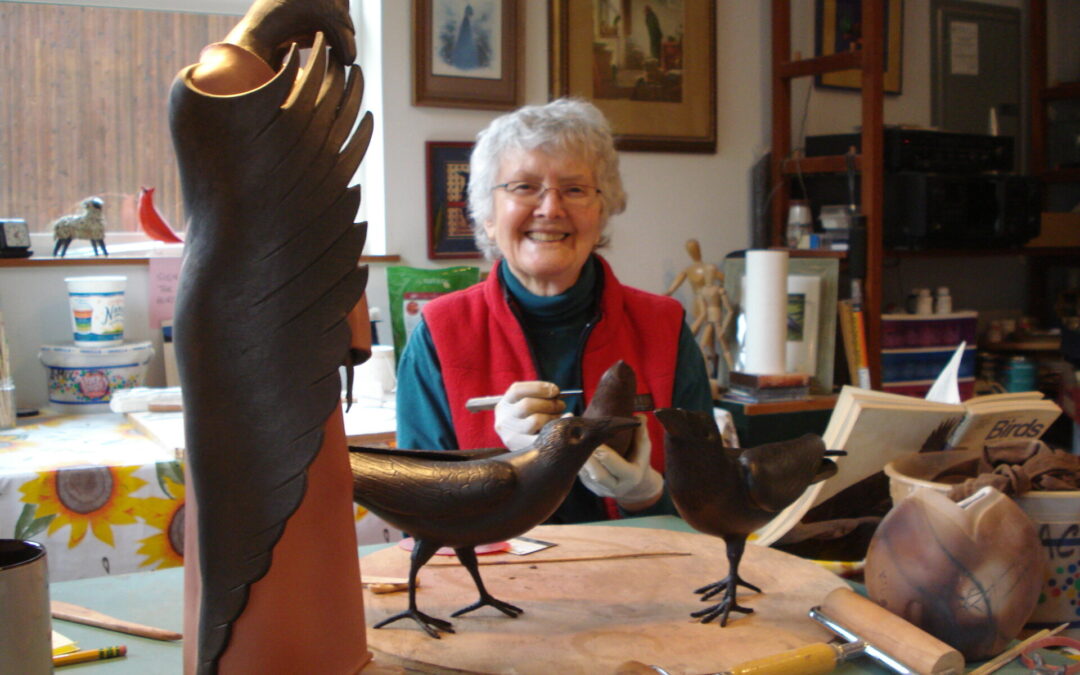It seems to be easy for people to recognize their Critical Parent. When it presses it’s Toxic Beliefs on you, you feel it right away with a tightening gut or fists, flushed face, mental sense of being overwhelmed, prickling on the back of your neck or other body fight-or-flight reactions. Here’s an example of how your Adult and Wise Parent can limit its impact and keep you calm.
Ann Kelly, pictured above in her cozy pottery studio, demonstrates as a teacher the effects of not subscribing to Belief #3. This belief holds that when people, including yourself, don’t meet some standard you’ve set, they must be blamed and/or punished. In her studio, after I accidentally stained her new gray carpet with fine red clay, she had every right to chastise me. Instead, she provided a towel to put below my table and assured me that the stain might come out with a thorough cleaning. I felt awful, but without the clutch in my gut I would have had in my younger years, partly due to her kindness, and partly due to my work to reduce the power of belief #3.
What happens in your particular body when you’ve made a mistake that hurts someone else? That’s your Adult’s signal to step in and assure your Child that your life is not at stake. Remember, your body can’t help with complex problems. It’s only designed to save your life, not your friendships or your reputation. Ann helped reassure me with her kind response, but you can’t count on others to help you. Your Adult must quickly jump in to keep your Child from fight-or-flight .
How did I teach my stomach to butt out? First, I’d clutch in some situations and afterwards review what went on with my Parent and Child for that to happen. I’d see that belief #3 in some form was in play. My Critical Parent would scold my Child, saying, “How dare you be so careless when such a generous and kind woman is helping you?” And then my Child would tell itself, “I can’t stand it that I’m such a screw-up!” That would trigger my fight-or-flight response, the stomach clutch. You may be thinking, that’s not really fleeing or fighting. Herbert Benson, who studied this for much of his life, noted that when we don’t go actively into fight-or-flight, our body just stews in a toxic funk with our reaction. Benson says our bodies would be healthier if we did run away or strike out.
So instead of stewing with my guts in a knot after I stained Ann’s carpet, I felt a milder upset in my body and my Adult wasn’t overwhelmed by toxic fight-or-flight chemistry. After many years of work to manage the impact of belief #3, my Adult had built me a Wise Parent, who quickly offered reassuring comments for my Child. They went like this: “You know you always have trouble with this kind of situation and it doesn’t help to get all upset. You forgive others who harm you and you must forgive yourself too. You’re just human and you can’t help making mistakes.”
If Ann had joined my Critical Parent to scold my Child, my Wise Parent have added this: “You know how much you always want others’ approval (Belief #1), but you can’t always have it, especially if you create problems for them. They may still subscribe to Belief #3, but you don’t have to join them. Stay calm so our Adult can focus on solving the problem.” I’m happy to report that it’s taken a long time, but this Wise Parent self-talk is now more powerful than my Critical Parent’s and my gut doesn’t clutch so badly unless a car is coming at me down the road.
After a mistake one day a few years ago, my Wise Parent coined a reminder phrase to summarize my revision of Belief #3 and help my Adult jump in quickly: “I never deserve to feel that bad.” I had to evaluate whether I could really believe this: “Would I ever want another well-meaning person to feel that bad? No. Do I try to consider the other person most of the time? Yes. Do I demand that others be perfectly considerate of me? No. So I can give myself a break.” And just for the record, I did manage to get the stain out of Ann’s carpetJ
Part I, chapters 3 and 4 of Claim Your Own Mental Fitness describe this process in more detail and for all Twelve Toxic Beliefs. How this applies for other fight-or flight responses, like anxiety, cravings, anger, grief or depression is described in Part II. How to apply this in other situations with people like friends, co-workers, relatives, marriage partners or kids is covered in Part III. When you’ve mastered this process for both your inner-world fight-or-flight reactions and with your social contacts, you will enjoy true mental fitness and the inner peace it brings.
*Herbert Benson with Miriam Z. Klipper, The Relaxation Response, 1992.

